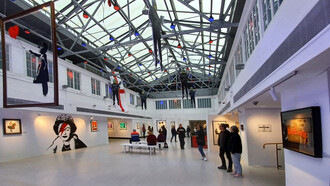The village of Asolo, so rich in present and past treasures, needs no introduction. A day is not enough to thoroughly enjoy its marvels and to follow the footsteps of those who marked its history permanently. We are talking about the ‘British community’ above all, who modelled its future for decades. Starting from Robert Browning who elected it as his inspirational place, inventing the verb ‘Asolando’ for a collection of poems dedicated to the village, written to depict the mood that accompanied him during his walks; allowing him to lose himself in his thoughts thanks to the beauties of the surrounding landscape.
The remarkable British traces and the fascination for such a unique territory – not too far from Venice, but with its own characteristics – are the key starting points for our visit to the Museo Civico. For these reasons, the wall dedicated to ‘The English in Asolo’ obliges the visitors to stop for some minutes to understand what is waiting for them in the next rooms.
The aforementioned Robert Browning (a small section is dedicated to him) is not the only Browning to be remembered here, as his son Pen opened the Tessoria Asolana for the artistic weaving of silk. The laboratory was also managed by Flora and Freya Stark: mother and daughter who had the chance of creating professional bonds and becoming friends with the Queen Mother and Queen Elisabeth II.
It is the memory of Freya Stark herself to dominate the museum thanks to the recent creation of a room inspired by her, on the 25th anniversary of her death. Stark is considered as the pioneer of travel writing and thanks to her passion for travelling, this ‘Wunderkammer’ was created - uniting three elements - to start a really adventurous journey.
The intensely white room, reproduces original furniture which belonged to Stark: her circular desk (the measurements of which were deducted by a photograph) evokes her life as an explorer, allowing the visitor to discover new worlds drawer after drawer, button after button; without leaving behind any travel minute, any consideration about life or a perfect piece of embroidery. An art that allowed her to open her personal window on the world, together with her five o’clock tea.
We then manage to open the wardrobe, the real heart of the room where we are invited to enter to get to know some of the most important phases in her biography, starting from important objects which belonged to her. However, as all journeys start and end with a door, before approaching one full of photographs, we are given the opportunity to enter another in order to live a unique sensorial experience aimed at listening to an interview dated 1963 where she describes herself: as ‘being particularly fascinated by abstraction’. Words reminding us of her qualities as a painter (as seen in a 2014 exhibition at the museum) and as a cartographer, abilities richly documented in this section. A section created in the middle of a floor inspired by three women who have been fundamental for Asolo, such as Queen Caterina Cornaro and Eleonora Duse.
The wide room dedicated to the Divine Duse is a room/changing room where we can admire the bequest donated by her daughter Enrichetta, a collection including a series of scenery sketches by Natalia Goncharova for a work by Ibsen, annotated by Duse herself; photographs and portraits by such masters as Walter Clark and Franz von Lenbach.
The Museo Civico of Asolo also owns an interesting archaeological section and a picture gallery, covering many centuries and including works by Canova and Bernardo Bellotto. The impressionist and pre-raphaelite landscapes by Eugene Benson lead us to the temporary monographic exhibition dedicated to Guglielmo Talamini, an artist between classicism and avant-garde, long forgotten and now brought to light thanks to this comprehensive exhibition of all his works, donated by his widow in 1923.
Paintings which were not entirely appreciated by the then director Malipiero and that now are given the right acknowledgement in this exhibition in both Asolo and Pieve di Cadore (where he was born). Paintings which remind us of Turner’s quest for light, with divisionist and symbolist echoes. Our visit ends with the marvellous ‘Vendemmia asolana’ (‘Grape harvest in Asolo’), exhibited at the Biennale in 1914. The painting is hung in a room inspired by Myth and Muses, leaving us anxious to know what the future museum events will be.















